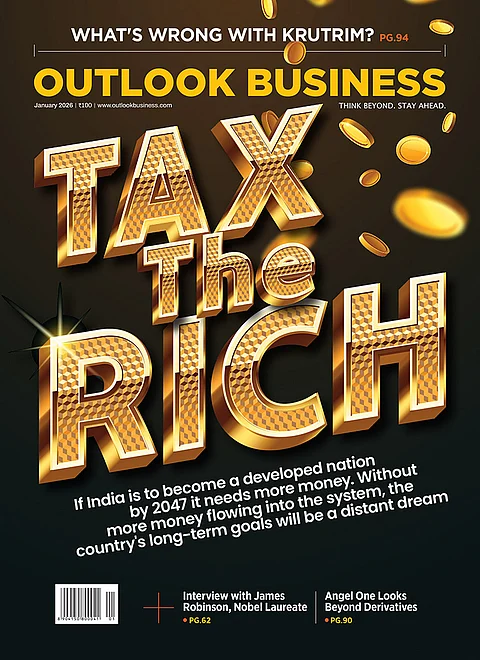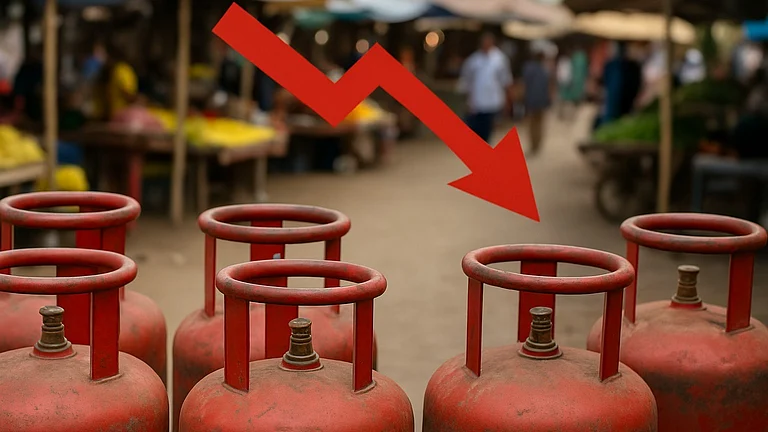Saugata Gupta strongly subscribes to the credo that change is the only constant. And if one does not capitalise on this change, they cede ground to someone else. As MD and CEO of Marico, he is pushing for diversification of the fast-moving consumer goods company’s portfolio in a bid to reduce its dependence on core brands. Speaking with Outlook Business, Gupta revealed that the company has identified enough growth opportunities, especially in food and digital and has internally charted diversification, distribution, digital and diversity as the four drivers for growth. While he maintained that diversification has a lead position in its growth agenda, the others will feed into each other. Edited excerpts from the interview:
How have high inflationary pressures impacted Marico’s input cost in terms of raw materials like copra and manufacturing and packaging costs?
From a holistic perspective, there have been significant input cost pressures. Usually, when there is high food inflation in a country, consumers tend to downtrade on FMCG—be it in urban or rural areas. Hence, it is very important for us to protect consumer franchise, market share and penetration.
We initially thought that the current geopolitical crisis following Russia’s intervention in Ukraine would be short lived but it appears to be otherwise. The current input costs are not structural demand led but are more supply chain inflation. We are coping with this status quo without taking unprecedented price increases.
Moreover, while copra had significant inflation last year, it has been relatively benign this year. Hence, a significant portion of our raw material is protected. So, while we have hiked prices by around 6 per cent to 7 per cent, we are careful about not passing on everything to consumers and are absorbing some of the price increases.
How is Marico dealing with these challenges with regard to taking calibrated pricing actions that protect its business and ensure customer retention?
We are looking at various combinations in terms of price points. In certain cases, we took down certain millilitres of our products. We are doing this mix and match because it is very difficult to pass on everything to the consumer, especially since the overall demand situation is stressed and will continue till Q2.
For e.g., this quarter last year was when everything was shut. The Delta variant was prevalent and there was higher in-home food consumption. Obviously, larger companies, with better agility and supply chain preparedness, managed. We had a 25 per cent volume growth in Q4 FY21 and then 21 per cent volume growth in 2021-22. So, we are lapping very high bases. Things should normalise and get into a decent situation closer towards the end of Q2.
While it is a stopgap arrangement, is shrinkflation a sustainable model?
Shrinkflation is more evident in food products where you keep adjusting the grammage or millilitres till it becomes untenable for a consumer. Since we do not have this situation, we are doing it selectively in a couple of products. But, we have to protect franchises and sometimes outlays become important. Hence, we introduced bridge packing which means if you do not have a pack between 300gm and 500gm, you introduce a 400gm one. It is important to manage consumer outlays because you risk downtrading.
Spending power in the rural market has seen a steady dip due to inflation and compressing demand. How is Marico dealing with this setback?
Marico’s rural market is lower than other FMCG players’. Our Saffola franchise and premium digital brands business are completely urban.
When the consumer wallet is challenged, it makes more sense to provide consumer value. We are taking steps in terms of cost management so that our margins do not get diluted to a threshold level. Since there is no pressure on copra, we are relatively more comfortable than other players as far as cost is concerned.
Moreover, some steps by the government to control inflation will at least ensure there is no further rise in inflation. A combination of rural direct benefit transfer, coupled with predictions of a good monsoon, will cause things to improve.
A significant amount of distribution in rural, in the past, was through indirect wholesale—be it primary or secondary. With all the changes taking place, the saliency of wholesale, as a channel, is going down and the business model might not have long-term sustainability. Only the lead and high-throughput brands can be driven through the wholesale channels. Direct distribution is very critical to drive range and availability.
The challenge is the investment and its breakeven, followed by last-mile execution. These can be overcome with automation and improvement in infrastructure. The moot point is to stay invested and execution is a very critical part in achieving that.
Once the consumption sentiment normalises, we expect the core franchises of coconut oil, Saffola edible oils and value-added hair oils to grow healthily in line with the stated medium-term aspiration while foods and digital businesses scale up at a much faster pace. As we have recently met our target in FY22 for healthy foods, we have set an aspirational goal of Rs 850 crore-Rs 1000 crore by FY24 on the back of innovation, distribution, and market development.

Talking about other players, is Patanjali, after the acquisition of Ruchi Soya, emerging as a clear threat for FMCG brands, especially in a shrinking market?
India is a large market with enough headroom for any FMCG player to grow. Ultimately, the penetration of branded packaged food is very low, offering enough opportunities for all players.
The long-term FMCG story in India is pretty much intact and there are some temporary headwinds now. Patanjali was there earlier, too, as was Ruchi Soya. While there is a marginal overlap, the issue is more about how you want to innovate, manage costs or drive new distribution channels.
So, how exactly is Marico innovating in driving distribution and product creation?
Since we continue to be invested in the long term, we have to cope with the short-term pressures. We continue to have headroom in core brands but the driver for our growth is premiumisation for our hair management business, growth in food, digital and other premium personal care products like male grooming and skincare which are essentially the long-term growth drivers.
We have two tasks as far as innovation is concerned. Firstly, we still have a long way to go in realising rural potential. Hence, direct distribution is a task on hand. To support our new portfolio in urban markets, we aim to play a larger role in chemists, food and cosmetic outlets. In terms of distribution, it is primarily focused on modern trade and ecommerce with an urban focus.
While your lead brands are well-known, a lot of aggressive marketing is needed to create awareness for your digital-first brands. How is Marico working on that to meet its distribution challenges?
We will not focus on digital-first brands in the rural markets since it is essentially focused on the urban sector where there is enough opportunity. At the same time, a lot of mass products, like value-added hair oil or hair gel, are potentially rural.
When I look at the reach of lead brands like Parachute or Shanti Amla versus the reach of the next set of brands, there is a gap to be plugged. It is not that the product is not available. The question is about quality of availability and distribution with investment behind infrastructure with automation which can be significantly upped. Traditionally, we have been a little under-indexed in some key markets like Uttar Pradesh and Tamil Nadu where we have a lot of work to do.
Can you elaborate how you plan to get this work done?
Firstly, it is about having the right infrastructure partners in terms of super stockists and distributors. Secondly, we have a real-time secondary sales feed from the urban market because we sell through most of our distributors. These sell through third-party distributors, so the automation part involves extending this to rural areas. The third aspect is about investing on indirect feet on the street. Sometimes, it is cost effective to use the indirect channel. However, after some time, it is best to do direct distribution which gives you more competitive advantage.
Many stockists and distributors have been under pressure because throughput slowed, demand dropped while credit cycles remained the same. Are you going to realign your credit cycles keeping the current situation in perspective when demand still is muted?
Yes, in the rural market, credit is an issue. But, more than that, it is about supply chain efficiency to manage stock levels. At the end of the day, we have to manage the return on investment of our distribution partners. The levers for this RoI are not just credit, it is also about stock and how much you are subsidizing the initial costs.
We are extremely cognisant of the fact that the RoI for our distribution partners has to be in place to make it a sustainable model. As you expand in rural, you have to be in investment mode for the first couple of years because it takes two-three years to break even.
Marico has added three digital-first brands—True Elements, Just Herbs and Beardo—to its portfolio. How are you using your experience from these start-ups to seed organic digital brands internally?
The acquisition of Beardo and Just Herbs has given us a lot of learning. We are tuned to the operating model of a large FMCG while they look at far more fragmentation, niche SKUs and faster velocity of innovation by taking small, but multiple, bets. It helped us in transplanting this operating model and culture to organically grow our digital brands. Some digital-first brands give us significant scale in terms of also ensuring a lot of synergies whether it is tech stack, logistics or performance marketing.
We aim to accelerate our digital transformation journey by building a portfolio of at least three digital brands, either organically or inorganically, with a combined turnover of Rs 450 crore to Rs 500 crore by FY24. The acquisition of Beardo and recent strategic investments in Just Herbs and True Elements are conscious steps in this direction.
The annualised exit run rate for digital business in FY22 was Rs 180 crore to Rs 200 crore. We clocked an exit of Rs 180 crore to Rs 200 crore last year. This is because we continuously scale them up and are already spending over 20 per cent of our spend on digital. This will also accelerate our digital capabilities on the core brands.
Can you share specific instances of learnings from the digital-first brands?
One is the cycle time of innovation. When you launch a digital brand originally, you crunch the scale, unlike a mass brand. There are a lot of test and learn methods in this sector.
The second thing that we have incorporated in some of our learnings is the risk appetite and looking at certain trends. We were very late in launching onion oil because WOW Skin Science and Mamaearth had already done it. In the future, we are in a much better position to track the next onion oil kind of trend and launch a product accordingly. We are far more prepared and able to pick up a trend in the digital space and experiment with it than we were a couple of years ago.
Moreover, traditionally, FMCGs have a typical talent profile with most people having an engineering background. Start-ups have a different set of talents. Based on our experience in the start-up-led brands, we are now able to recruit and offer interesting careers to this diverse set of talent. When we talk about diversity, it is often about gender, but there is also diversity of thought. This is also bringing a different set of talent with the mindset to manage those brands.
The culture in traditional FMCG companies and that in start-ups are very different and amalgamating the two can result in a culture clash. How has Marico avoided this and ensured cohesion in the talent pool?
We are keeping the two operating models separate for exactly this reason. The leadership, operating models, systems and compensation in the digital brands is separate from that of the core brands. So Beardo is based in Ahmedabad while Just Herbs operates from Chandigarh. We have kept the two businesses separate and run two parallel systems so that they can run independently with separate key performance indicators, compensation and talent pool.
At the same time, each is learning from the other to adapt. For example, the digital brands are learning to put more process in the madness, while our core brands are learning about agility and risk taking. Digital brands are aspirational for many people but when we tried moving some of our own people there, some have succeeded and some have failed. Hence, we are bringing in different sets of people to manage these companies.
Trends spotting is quite challenging because it could well turn out to be a fad. How does Marico identify long-lasting trends?
In the case of FMCG, personal care or food, a fad can become a trend if the leader builds on it. Look at aloe or olive oil. There were people invested in driving that trend to make it popular. Obviously, it should offer some benefit.
Today, we see activated charcoal in toothpaste, skincare or facewash. Turmeric latte has become popular overseas and it is a key ingredient in various products. So, if someone invests in these traditional ingredients or habits, it comes full circle. If there is enough investment behind a fad, it becomes a trend that you can milk and leverage as innovation.
FMCG is not as transient as fashion which is also very seasonal. Till a few years ago, male grooming was an unexplored area but is a big industry now. There are pioneers who invest in it. In personal care, a lot of trends in Asia are led by Korea and Japan. Many skincare trends come from K-beauty and then it transcends into other countries. As far as Marico is concerned, we pick up some ingredients based on social listening.
What are your predictions for the food business?
We believe plant protein, especially soy based, will become big. It is also time to grow the trend for millets which are a mainstay in traditional Indian cuisine. This interest is largely because of democratised and digital media where people have access to lots of content. In today’s digital world, social listening is a strong tool in trend spotting.
Also, one should be mindful about ingrained habits. Mock meat might not have lots of takers in India as an alternative because of the large vegetarian base. But if you push it as plant protein, it could have better uptake.
If an ingredient or product offers long-term benefit, it will not die down. Moreover, when penetration is low in a particular category, we welcome competition. Awareness building is augmented if four players are creating noise vis-à-vis one player investing there.
The ready to cook and ready to eat business has seen a huge fillip in recent years. Is there a possibility of Marico getting into that space?
In India, ready to cook is a bigger market as compared to ready to eat because there are alternatives available. We are already present in soy plant protein and recently launched peanut butter and mayonnaise, so we are looking at spreads.
But, we want to get into more mass market products and categories that have a tailwind for growth. We will look at anything that falls into three buckets—snacking in between meals, immunity products or accompaniments.
However, we are clear that anything Saffola does has to be good for you and not complete indulgence. For example, our peanut butter does not have sugar and is made of jaggery which is healthier than other options available.






























